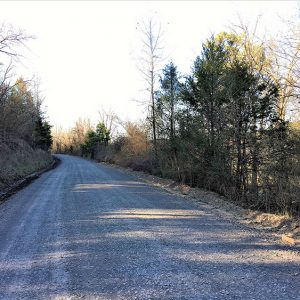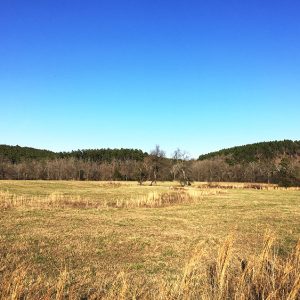calsfoundation@cals.org
Blansett (Scott County)
Blansett is an unincorporated community in west-central Scott County. It was established in 1877 along the Black Fork of the Fourche La Fave River, which flows west through the Ouachita National Forest. The small community is surrounded mostly by forest, with some areas containing pastures.
Evidence from the Archaic, Woodland, and Mississippian periods has been found throughout the area. The Caddo tribe once had a strong presence throughout Scott County, especially along prominent bodies of water. Numerous archaeological mounds have been discovered along waterways throughout the area, including Black Fork Creek.
There is little evidence of early European exploration around Blansett. However, it is likely that French trappers and explorers traversed the rivers and creeks around Blansett in the late seventeenth and early eighteenth centuries.
The first settler in Blansett arrived prior to the Civil War. The community was named after Jim Blansett, who was one of the first settlers. Around 1840, early settler Tom Gist led his family from Georgia to Arkansas, settling near present-day Blansett. Gist established two farms in the area and operated a horse-powered cotton gin. The area where Gist lived was known as Gist Town. Gist had three sons: John (Bud), Joe, and Jim. John Gist married Liza Richmond; after she died, he married Marthy Livesay. Jim Gist was killed in a gunfight near Ross Creek. Tom Gist also had two daughters who married two brothers from the area by the name of Wood.
During the Civil War, several bushwhacker attacks and other acts of violence took place in Blansett. Jim Blansett reportedly threatened a family to give him a large sum of money they supposedly possessed. When the family refused to give him the money, he burned their house down. Afterward, the head of the household followed Jim Blansett home and killed his horse.
After the Civil War, the community began to grow due to families leaving other war-torn areas of the country. One of the first buildings to be built in Blansett was a church, which also served as the school house, built by 1883. The old church/school also served as a community center. Activities such as singing, pie suppers, and July 4 celebrations were held there. Blansett also had two general stores, a cotton gin, a grist mill, a sawmill, a drugstore, a blacksmith, and a post office. One of the general stores was opened in 1881 by Samuel G. Brown. He also served as post master for a few years and operated the sawmill and cotton gin in 1888. Early logging was done with oxen, while mules were used to haul the lumber to the mill. Mail was brought to Blansett over Henry Mountain by horseback or buggy. The post office was built on Tennessee Young’s property; he also served as postmaster for several years after it was built. Baseball was a common game played within the community. Young men from Ross Creek would often play against the Blansett team.
In May 1882, the Scott County Courthouse burned, destroying all records that defined the boundaries of the various school districts that had been established throughout the county. Several months later, in August, the county court re-established the boundaries of the fifty-six school districts active in the county, including Blansett School District (Number 33).
The saw and grist mills located in Blansett closed soon after World War I. In 1920, the church/school building burned down. A new school was built soon after. A new Baptist church was also organized in 1909, but the building was not constructed until 1920. That same year, as many as seventy-five students attended the Blansett School; in the late 1930s, fewer than twenty remained. The school was closed around that time and consolidated with a school at Oliver Creek.
After World War II, the Blansett community continued to dwindle. In 1945, the school was consolidated with Waldron (Scott County). In 1958, Eloyce and Grace Garner sold their farm, which had been in their family since 1885. Cora Garner had received the land from her father, William T. Brown, who homesteaded there. This land joined the plot where one of the general stores was located.
In 1977, Afton and Christine Kelly purchased the Garner land. The isolated community has only a few residents in the twenty-first century. The landscape surrounding the area consists of mostly forest with some pastures located along Black Fork Creek.
For additional information:
Biographical and Historical Memoirs of Western Arkansas. Chicago: Goodspeed Publishing Company, 1891.
Cate, Michael. History of Scott County, Arkansas. Dallas, TX: Curtis Media Corporation, 1991.
Goodner, Norman. A History of Scott County, Arkansas. Siloam Springs, AR: Bar D Press, 1941.
McCutchen, Henry Grady. History of Scott County, Arkansas. Little Rock: H. G. Pugh and Company, 1922.
Ty Richardson
Richardson Preservation Consulting
 Blansett Bridge
Blansett Bridge  Blansett, North End
Blansett, North End  Blansett
Blansett  Blansett, South End
Blansett, South End  Scott County Map
Scott County Map 



Comments
No comments on this entry yet.